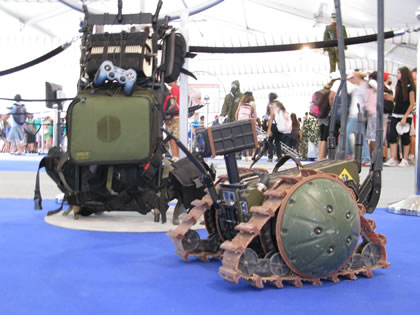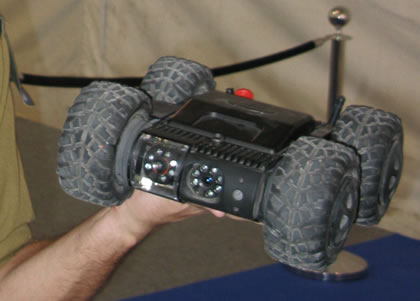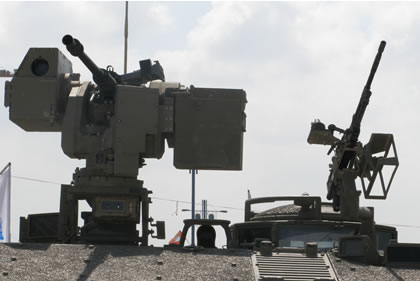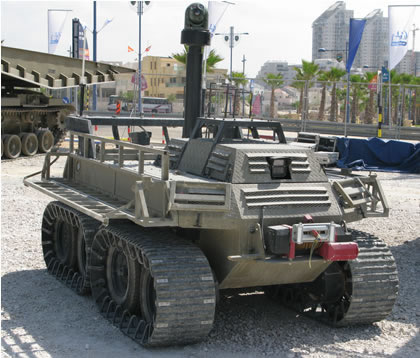Israel’s IDF & Military Industries 60 years exhibition included a number of robotic and remotely controlled systems. Some systems are already operational, such as the Tanin and TAGS robotic vehicle described below. Others, like the Guardium, have just been fielded this year and are about to enter operational service soon. Among the miniature robotic systems under development by the Israeli industry were the Viper, developed by Elbit Systes and four-wheel Eye-Drive by ODF. Among the larger systems on display here were the FrontRunner robotic engineering vehicle, developed by IAI Ramta, Zoko industries and InRob.
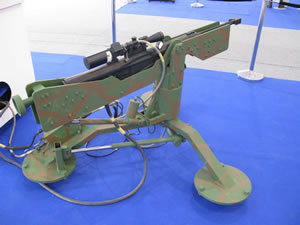 Remotely controlled sniper weapon-mount was unveiled here by the IDF special projects development unit Yiftach. The system, dubbed Tanin (Alligator) mounts a Barret 0.5″ semi-automatic heavy sniper rifle, positioned on an electrically powered, remotely controlled fixture capable of aiming the rifle at targets up to 3 km in range. These weapon are typically positioned near remotely operated observation posts, enabling operators to rapidly engage targets within their area of responsibility. The system is equipped with a firing safety features inhibiting inadvertent firing of the weapon. The system weighs about 120 kg and is designed for operation at fixed sites. The unit has also developed a deployable, lightweight system designed for automatic sniper rifles. Other remotely controlled weapon stations (RCWS) on display at the exhibition included the Wave system, developed by IMI, demonstrated on IMI’s up-armored M-113 and the Samson RCWS, developed by Rafael, shown mounted on the Namer.
Remotely controlled sniper weapon-mount was unveiled here by the IDF special projects development unit Yiftach. The system, dubbed Tanin (Alligator) mounts a Barret 0.5″ semi-automatic heavy sniper rifle, positioned on an electrically powered, remotely controlled fixture capable of aiming the rifle at targets up to 3 km in range. These weapon are typically positioned near remotely operated observation posts, enabling operators to rapidly engage targets within their area of responsibility. The system is equipped with a firing safety features inhibiting inadvertent firing of the weapon. The system weighs about 120 kg and is designed for operation at fixed sites. The unit has also developed a deployable, lightweight system designed for automatic sniper rifles. Other remotely controlled weapon stations (RCWS) on display at the exhibition included the Wave system, developed by IMI, demonstrated on IMI’s up-armored M-113 and the Samson RCWS, developed by Rafael, shown mounted on the Namer.
Several UGVs were displayed at the exhibition, among them the Tactical Amphibious Ground Support vehicle (TAGS), built by Dumur Industries of Canada. The original system that weighs about 1.7 tons was enhanced in Israel increasing the curb weight to two tons, increasing payload capacity to 1 ton. The IDF is considering using the TAGS in support of infantry units operating in urban operations, utilizing the robot to transport some of the equipment used by the infantry unit, and deliver critically needed supplies such as ammunition, in areas threatened by hostile fire. TAGS can also be used to carry casualties under fire, in conditions that would expose the medical team to high risk.
The Israeli configured TAGS mounts an elevated a video/flir sensor payload, utilizing an IAI/Tamam miniPOP payload, a forward looking driving camera and illumination system, an electronic control package and payload carriage rigs. The TAGS can operate at a range about one kilometer from the control station, located inside a specialized armored vehicle. However, the IDF does not limit the use of TAGS to support missions only. A new configuration recently entering field testing mounts a lightweight weapon station, complemented with an EO payload, enabling units to utilize the robot as a forward deployed fire base.

